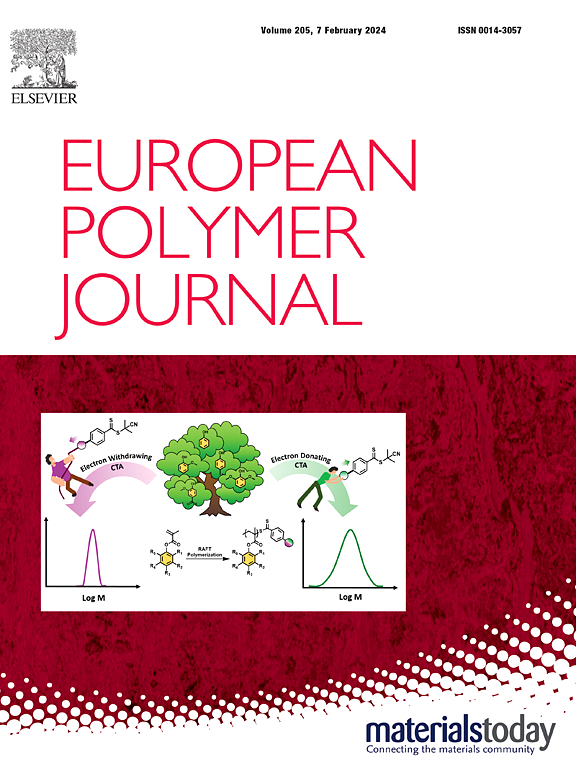Synthesis of hyperbranched polyphenylsilsesquioxane–dimethylsiloxane copolymer by the Piers-Rubinsztajn reaction and its properties
IF 5.8
2区 化学
Q1 POLYMER SCIENCE
引用次数: 0
Abstract
In this study, a synthesis of hyperbranched polyphenylsilsesquioxane–dimethylsiloxane (hb-PPSQ) copolymer via the Piers-Rubinsztajn (PR) reaction has been developed from a PhSi(OEt)2OSiMe2H AB2-type monomer. The hb-PPSQ formation pathway and the influence of reaction conditions (the monomer feed rate, concentration and amount of the monomer, reaction temperature) on the molar mass characteristics of the resulting hb-PPSQs were investigated by 1H, 29Si NMR, MALDI, FTIR, and GPC techniques. The reaction of the said monomer initially produces cyclic phenylethoxydimethylsiloxane. Further molar mass growth is possible when a fresh monomer is added to the reaction cycle. Thus, EtOSi-end capped hb-PPSQ with a molar mass of 24.5 kDa and DB≈0.5 was obtained. The terminal ethoxy groups of the resulting hb-PPSQ can be modified by the one-pot PR reaction with triorganosilane to give hb-PPSQs with a variety of end groups. In this way, SiMe2Ph- and SiMe2Vin-terminated hb-PPSQs were obtained. Their hydrodynamic and thermal properties were studied. These polymers have low glass transition temperatures (∼ −60 °C) along with high onset decomposition temperatures (∼ 400 °C).

pierre - rubinsztajn反应合成超支化聚苯基硅氧烷-二甲基硅氧烷共聚物及其性能
本研究以 PhSi(OEt)2OSiMe2H AB2-型单体为原料,通过皮尔斯-鲁宾斯泰因(Piers-Rubinsztajn,PR)反应合成了超支化聚苯硫醚-二甲基硅氧烷(hb-PPSQ)共聚物。通过 1H、29Si NMR、MALDI、FTIR 和 GPC 技术研究了 hb-PPSQ 的形成途径以及反应条件(单体进料速率、单体浓度和用量、反应温度)对生成的 hb-PPSQ 摩尔质量特性的影响。上述单体的反应最初会产生环状苯乙氧基二甲基硅氧烷。当在反应循环中加入新的单体时,摩尔质量有可能进一步增长。这样,就得到了摩尔质量为 24.5 kDa、DB≈0.5 的乙氧基末端封端的 hb-PPSQ。所得 hb-PPSQ 的末端乙氧基可通过与三有机硅烷的单锅 PR 反应进行改性,从而得到具有各种末端基团的 hb-PPSQ。这样就得到了以 SiMe2Ph- 和 SiMe2Vin 为端基的 hb-PPSQ。研究了它们的流体力学和热学特性。这些聚合物具有较低的玻璃化转变温度(∼ -60 °C)和较高的起始分解温度(∼ 400 °C)。
本文章由计算机程序翻译,如有差异,请以英文原文为准。
求助全文
约1分钟内获得全文
求助全文
来源期刊

European Polymer Journal
化学-高分子科学
CiteScore
9.90
自引率
10.00%
发文量
691
审稿时长
23 days
期刊介绍:
European Polymer Journal is dedicated to publishing work on fundamental and applied polymer chemistry and macromolecular materials. The journal covers all aspects of polymer synthesis, including polymerization mechanisms and chemical functional transformations, with a focus on novel polymers and the relationships between molecular structure and polymer properties. In addition, we welcome submissions on bio-based or renewable polymers, stimuli-responsive systems and polymer bio-hybrids. European Polymer Journal also publishes research on the biomedical application of polymers, including drug delivery and regenerative medicine. The main scope is covered but not limited to the following core research areas:
Polymer synthesis and functionalization
• Novel synthetic routes for polymerization, functional modification, controlled/living polymerization and precision polymers.
Stimuli-responsive polymers
• Including shape memory and self-healing polymers.
Supramolecular polymers and self-assembly
• Molecular recognition and higher order polymer structures.
Renewable and sustainable polymers
• Bio-based, biodegradable and anti-microbial polymers and polymeric bio-nanocomposites.
Polymers at interfaces and surfaces
• Chemistry and engineering of surfaces with biological relevance, including patterning, antifouling polymers and polymers for membrane applications.
Biomedical applications and nanomedicine
• Polymers for regenerative medicine, drug delivery molecular release and gene therapy
The scope of European Polymer Journal no longer includes Polymer Physics.
 求助内容:
求助内容: 应助结果提醒方式:
应助结果提醒方式:


